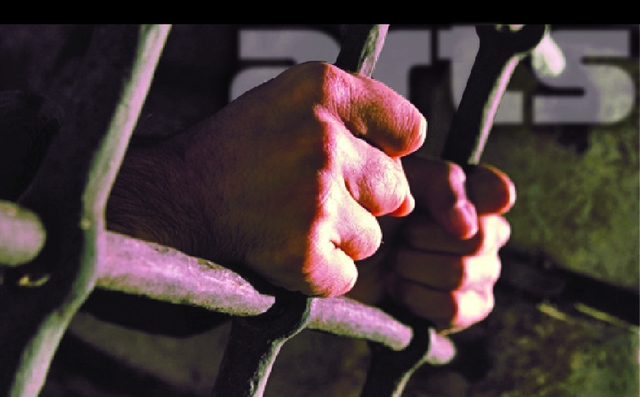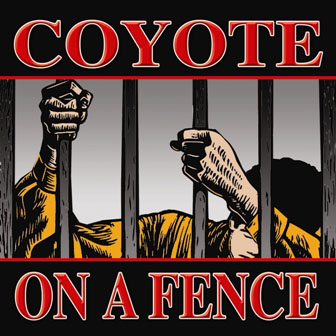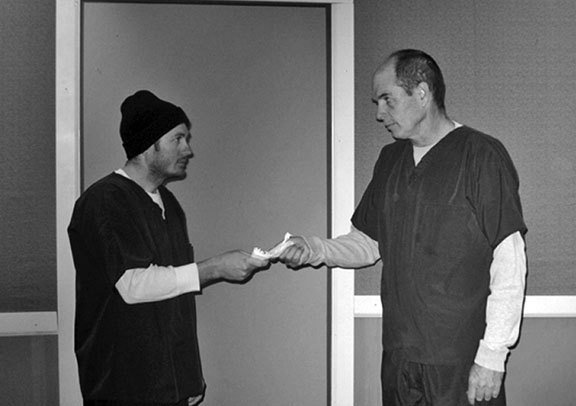The Desert Rose Playhouse is hard to find. Located in a Northeast Heights strip mall alongside an optician and next to a car wash, the MapQuest directions aren’t wrong; it’s just that it doesn’t seem like it’s supposed to be there. It’s a long way from the theater nexus of Nob Hill and Downtown. The theater space itself is small. The heater, and what felt like the air conditioner, kicked on at several points during my viewing of Coyote on a Fence, the loud whirring threatening to upstage the players. There were approximately nine people at this Friday night show, for which the theater was out of programs; all of which made me, let’s say, trepidacious about what was in store. Thank God the play was amazing. Coyote on a Fence , written by Bruce Graham and directed by John Hardman, is the story of death row inmate John Brennan (played by John Wily). Brennan, the editor of the Death Row Advocate , is older, white, educated and, by his claims, innocent. When Brennan’s cell partner Willy T is executed, young Bobby Reyburn (Andrew Leith) moves in. Bobby is developmentally disabled, eager to please, partial to animal impressions and a white supremacist who owns up to the guilt of the heinous crime for which he’s been sentenced. Brennan, rational and liberal, is appalled by Bobby’s ignorance and bigotry. They clearly don’t belong together.Watching over them is Shawna, a prison guard played by Angela Littleton. Two years from retirement, she’s patrolled death row since she was a young woman. The play opens with her in the spotlighted dark, sucking back Budweisers while talking to an unseen reporter at a club. It’s the night of an execution, and she attempts to mitigate the profundity of the death with bravado. To her, she says, it’s a job that pays overtime. “I sleep just fine.”There’s media attention surrounding Shawna’s prison because of Brennan’s newsletter, in which he publishes work by inmates as well as their obituaries, which he’s penned. Large media outlets, such as the BBC, have been drawn to covering Brennan and his story, raising the ire of prison officials.A play about the death penalty could easily become polemic, presenting clear choices, right and wrong. There are instances of fuzzy logic in the script, but the piece largely veers from asking us to condone or condemn the punishments. The real concern of the play is that of human connection and dignity. Are we simply the sum of our actions, or is ownership of those actions important? The actors’ nuanced performances do the bulk of the work in exploring these questions. Brennan is prickly and observant, our portal into understanding life on death row. Wily’s performance draws upon the audience’s need to identify with a character; we empathize with his anger, which at times flames into righteousness. He believes wholly in his cause, and that passion is seductive. Leith’s Bobby serves as a counterpoint to the careful and precise movements of Wily’s performance. If John Brennan is the ego, then Bobby Reyburn is the id. Bobby enters the scene in a bluster of unfocused physicality and a verbal deluge of racist epithets. He’s both childlike and chilling. Though Leith’s portrayal is stompy at times, his handling of Bobby’s racism is matter-of-fact; to him, the sky is blue, moms leave and whites are superior. He seeks no reaction and is puzzled by Brennan’s rejection of him.It falls to Littleton as Shawna to do some of the heaviest lifting. While the relationship between John and Bobby is at the center of the work, Shawna serves as our anchor in the real world. Her time onstage is split between the prison and the outside. Nursing a Budweiser, she is loud and funny, skeptical and deflecting. A lone woman sitting at a small table, it’s up to Littleton to create the semblance of a busy bar filled with people trying valiantly to be carefree. Littleton is a physical actor and she does it well. But it is her scenes in the prison, when often she is simply observing, waiting, watching, that are quietly compelling. The fact that Littleton is African-American is worth noting only because of how she chooses to react to the barrage of invective Bobby unleashes. The script itself is not specific about Shawna’s race, and so it’s up to Littleton to immerse herself in a character who has heard this garbage for decades. Watching what she chooses to respond to, and what she deadens herself to, is fascinating. The script is imperfect. Bobby is often given lines that ring too true, phrased with a poetry and preciseness that the rest of the time we’re led to believe is impossible from him. But each actor, including Niel Falconbridge as the New York Times reporter covering Brennan’s newsletter and life, creates depth beyond the page. This is the play’s New Mexico premiere, and it’s nice to see different work being staged, that is, if people go see it. So go see it.
Coyote on a Fence runs through April 5, with performances Friday and Saturday at 8 p.m. and Sunday at 2 p.m. Tickets are $12. For more information, go to desertroseplayhouse.com.











